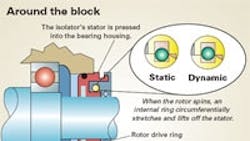There is a mechanical alternative to regular rubber bearing seals. Called an isolator, this component keeps contamination out and lubricant in bearing enclosures for non-contact protection. While bearing frequency harmonics and angular misalignment can separate traditional sealing systems, an isolator’s rotor and stator are unitized so they don’t separate during use. The two halves interact through mating grooves so the rotor turns with a rotating shaft, while the stator is pressed into a bearing housing.
Isolators come in solid and split configurations and accommodate shaft diameters from 0.625 to 108 in. Some utilize a blocking feature that inhibits the free transfer of vapor contamination when the rotating equipment is cycled on and off. One representative isolator design can operate with a continuous temperature limit of -40° to 400°F, shaft runout to 0.005 in. TIR, shaft-to-bore misalignments to 0.007 in., and shaft surface speeds to 12,000 ft/min.
Q&A
Q: What other systems are available?
A: Contact seals are also used to protect bearings. However, when worn seals aren’t promptly replaced, they compromise systems. For example, in a typical setup a rubber lip seal with a maximum useful life of 3,000 hours — 4.1 months — might protect rolling element bearings with a design life rating exceeding 150,000 hours — 17 years. As the seal’s condition deteriorates it can groove the shaft, carbonize at points of contact with the shaft, and finally lose its ability to effectively seal the bearing enclosure. This puts pricier bearings at risk. What’s more, all contact seals consume power — around 150 watts per contact surface — and cause heating of the lubricant and even the bearings.
Face seals have another challenging limitation. Whether spring or magnetically loaded, their failure is often abrupt and unpredictable. Due to the nature of their design, they are always taken out of service after failure and replaced, but not necessarily in kind.
Q:Where are bearing isolators most appropriate?
A: About 25 years ago, bearing isolators began replacing some lip seals in industrial pumps in various process industries. First installed by pump and motor manufacturers as optional features, they later became standard equipment on higher-duty products. Now bearing isolators are used to permanently protect bearings in many types of rotating equipment, including process pumps, electric motors from 1⁄2 to 10,000 hp, gearboxes and mechanical drive steam turbines. In fact, some manufacturer warranties are extended with bearing isolators.
Q: What about cost?
A: Bearing isolators generally cost ten times as much as a common rubber lip seal, though the cost of installation is about the same. In fact, the isolator’s higher initial cost is often justified by its longer, more reliable life. Most commonly made of bearing bronze, isolators are also made of stainless steel, titanium, and aluminum. As rotating equipment is routinely maintained and repaired, metal bearing isolators can be used over and over for many years. Also, bearing isolators do not require lubrication or any special shaft finish.
This month’s handy tips provided by David C. Orlowski of Inpro/Seal Co. in Rock Island, Ill. For more information, call (800) 447-0524 or visit www.inproseal.com.
About the Author
Elisabeth Eitel
Elisabeth Eitel was a Senior Editor at Machine Design magazine until 2014. She has a B.S. in Mechanical Engineering from Fenn College at Cleveland State University.
